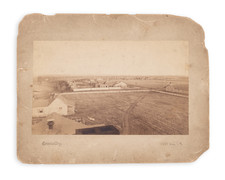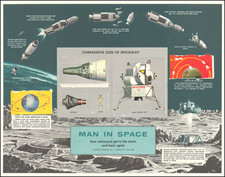One of the Most Iconic Images in Space Exploration.
This extraordinary image of Earthrise was captured by Apollo 8 Lunar Module Pilot William Anders as the spacecraft emerged from the far side of the moon during their third orbit. The remarkable moment left a lasting impression on Anders, who reflected on the unexpected significance of the sight before him. Anders stated:
We'd spent most of our time on Earth training about how to study the Moon, how to go to the Moon; it was very lunar oriented. And yet, when I looked up and saw the Earth coming up on this very stark, beat-up lunar horizon, and Earth that was the only color that we could see, a very fragile-looking Earth, a very delicate looking Earth, I was immediately almost overcome by the thought that here we came all this way to see the Moon, and yet the most significant thing we're seeing is our own home planet, the Earth.
The striking image serves as a testament to the incredible journey of the Apollo 8 mission and offers a poignant reminder of the beauty and fragility of our home planet, as seen from the perspective of those who ventured beyond its atmosphere.
With the purple ink NASA press release language on verso.
MANNED SPACECRAFT CENTER, HOUSTON, TEXAS
APOLLO 8 - - EARTH VIEW - - This view of the rising Earth greeted the Apollo 8 astronauts as they came from behind the Moon after the lunar orbit insertion burn. Earth is about five degrees above the horizon in the photo. The unnamed surface features in the foreground are near the eastern limb of the Moon as viewed from Earth. The lunar horizon is approximately 780 kilometers from the spacecraft. Width of the photographed area at the horizon is about 175 kilometers. On the earth 240,000 statute miles away, the sunset terminator bisects Africa.
Photo Number 68-H-1401
68-HC-870
GRIN DataBase Number: GPN-2001-000009
Apollo 8 was a groundbreaking mission in NASA's Apollo program, launched on December 21, 1968. It marked the first time a crewed spacecraft orbited the Moon, paving the way for future lunar landing missions. Astronauts Frank Borman, James Lovell, and William Anders embarked on a six-day journey, becoming the first humans to travel beyond low Earth orbit and witness the Earthrise over the lunar horizon. During their ten orbits around the Moon, the crew captured stunning photographs, conducted experiments, and broadcast live television images back to Earth. The success of the Apollo 8 mission demonstrated the capability of the Apollo spacecraft and the Saturn V rocket, instilling confidence in NASA's ability to achieve their ambitious goal of landing humans on the Moon.











![(Native American Photograph) [Fox On The War Path (Ke-wuk-o-car-war-ry), a Pawnee man of Indian Territory]](https://storage.googleapis.com/raremaps/img/small/93109.jpg)
![(Germany) [Sketch and Albumen Print Album / Travels Along the Rhine River, including Nuremberg] Reis langs den Ryn Frankfort, Heidelberg, Munchen, Weenen, Tyrol, Salzburg, Dresden en de Sachsische Schweiz](https://storage.googleapis.com/raremaps/img/small/89724.jpg)


![(Mexican Antiquities - Photography) [Western Facade of the Fourth Palace, Mitla, Oaxaca; Quatrieme Palais, à Mitla, façade occidentale] [Plate 15 from:] Cités et Ruines Américaines](https://storage.googleapis.com/raremaps/img/small/93940.jpg)
![(Cleveland Beer Drinkers) [Photograph of Zwiebel Brigade Drinking Beer in Cleveland]](https://storage.googleapis.com/raremaps/img/small/96294.jpg)